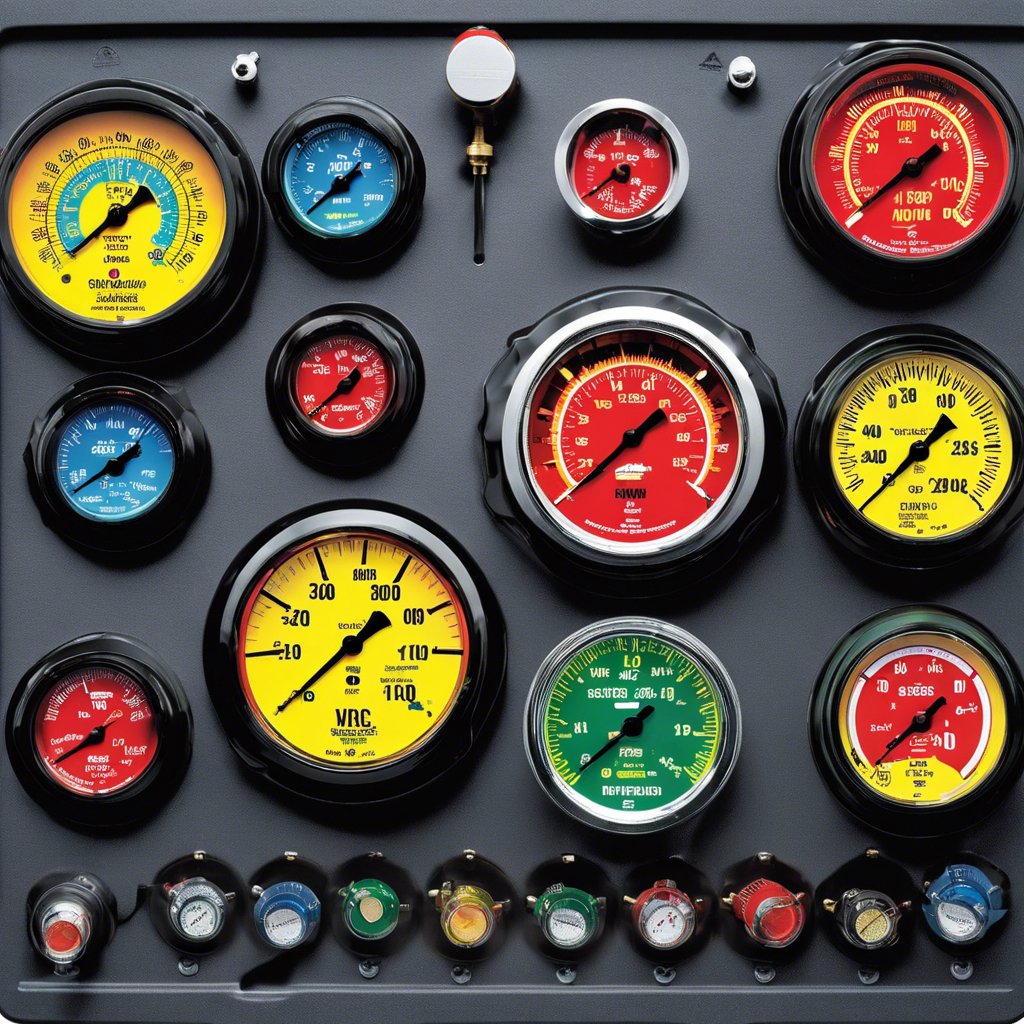Welcome to ‘HVAC Gauges 101: A Beginner’s Guide to Reading and Understanding.’
This comprehensive guide is designed to provide beginners with a clear understanding of manifold gauges in the HVAC industry. We aim to demystify the complexities surrounding these gauges, allowing you to confidently read and interpret their measurements.
Covering topics such as gauge operation, safety precautions, and refrigerant handling, this guide is an invaluable resource for those looking to improve their skills or refresh their knowledge.
By following this guide, you will gain the knowledge necessary to effectively utilize HVAC gauges and ensure proper handling. Whether you’re a beginner or a seasoned professional, this guide will help you navigate the world of HVAC gauges with ease.
Key Takeaways
- HVAC gauges measure and monitor pressure and temperature of refrigerant in HVAC systems, providing crucial information about system performance and identifying issues or inefficiencies.
- Proper zeroing of gauges and understanding valve operation are essential for accurate pressure readings and system protection.
- Temperature readings on gauges aid in troubleshooting and diagnosing HVAC systems, with evaporator and condenser temperatures reflecting heat absorption and release.
- HVAC gauges are valuable tools for troubleshooting systems, analyzing pressure readings, comparing to specifications, and maintaining optimal performance and efficiency.
The Purpose of HVAC Gauges
The purpose of HVAC gauges is to measure and monitor the pressure and temperature of the refrigerant in an HVAC system. These gauges provide HVAC technicians with crucial information about the system’s performance and help them identify any issues or inefficiencies.
By connecting the gauges to the system’s service ports, technicians can accurately measure the high and low side pressures, as well as the corresponding temperatures. This allows them to assess the system’s refrigerant charge, determine if there are any leaks, and diagnose any potential problems.
Additionally, HVAC gauges enable technicians to perform tasks such as evacuating and recharging the system, as well as troubleshooting and adjusting the system’s performance.
Different Types of HVAC Gauges
There are several types of HVAC gauges that are commonly used in the industry to measure and monitor the pressure and temperature of refrigerants in HVAC systems. Manifold gauges, which consist of a board on tube, are widely used. These gauges have hollow copper tubes that rotate when pressurized, moving the needle on the gauge.
Digital gauges are also gaining popularity due to their accuracy and ease of use. Analog gauges, on the other hand, remain useful for HVAC professionals who prefer a more traditional approach.
Regardless of the type of gauge used, it is crucial to zero the gauges before taking pressure readings to ensure accuracy and prevent potential system damage.
Proper handling of different hoses and understanding the functions of valves are also essential for maintaining safety and system integrity when using HVAC gauges.
Understanding Pressure Readings
Pressure readings in HVAC gauges provide crucial information about the state of the refrigerant in the system. These readings are essential for diagnosing and troubleshooting HVAC systems. Understanding pressure readings requires knowledge of how to properly zero the gauges, as accurate measurements rely on this initial step.
The knobs on manifold gauges control the flow of refrigerant and pressure readings, making proper valve operation crucial for obtaining accurate measurements and ensuring system safety. Different hoses connect to various parts of the refrigeration system, and their proper handling is crucial for safety and preventing system damage.
Additionally, understanding different types of valves and their functions is essential for proper refrigerant handling and system safety. Regular maintenance and repair of valve depressors and seats in hoses can ensure a proper seal and prevent leaks, emphasizing the importance of valve knowledge for maintaining system integrity.
Interpreting Temperature Readings
Temperature readings on HVAC gauges provide vital information for troubleshooting and diagnosing refrigeration systems. Interpreting temperature readings accurately is crucial for maintaining the optimal operation of HVAC systems. When using manifold gauges, it is important to understand the different temperature readings and their significance in assessing system performance.
The two main temperature readings on HVAC gauges are the evaporator temperature and the condenser temperature. The evaporator temperature reflects the temperature of the refrigerant as it absorbs heat from the indoor air. It helps determine if the system is effectively removing heat from the space. On the other hand, the condenser temperature indicates the temperature of the refrigerant as it releases heat to the outdoor environment. It provides insights into the system’s ability to reject heat.
Interpreting these temperature readings requires comparing them to the manufacturer’s specifications or industry standards. Deviations from the expected temperature ranges can indicate issues such as inadequate refrigerant charge, restricted airflow, or compressor inefficiencies.
Troubleshooting With HVAC Gauges
To effectively troubleshoot HVAC systems, technicians must utilize the valuable information provided by HVAC gauges. These gauges are essential tools that provide insights into the operating conditions of the system.
Troubleshooting with HVAC gauges involves analyzing pressure readings to identify any abnormalities or issues within the system. By comparing the pressure readings to manufacturer specifications or known standards, technicians can pinpoint problems such as refrigerant leaks, blockages, or faulty components.
Additionally, HVAC gauges can help determine if the system is operating within the appropriate temperature and pressure ranges. This information is crucial for diagnosing and resolving issues promptly, ensuring optimal system performance and efficiency.
Therefore, troubleshooting with HVAC gauges is an integral part of maintaining and repairing HVAC systems, enabling technicians to provide effective solutions and ensure customer satisfaction.
Frequently Asked Questions
How Do You Read the Gauges on a HVAC System?
To read the gauges on an HVAC system, one must understand the pressure readings and interpret them correctly. Troubleshooting techniques involve identifying abnormal pressure levels, understanding the refrigeration cycle, and using the gauges to diagnose system issues accurately.
What Is a Good Reading on AC Gauges?
A good reading on AC gauges is one that accurately reflects the pressure of the system. This is achieved by zeroing the gauges, ensuring proper valve operation, understanding valve types, handling hoses correctly, and wearing gloves for safety.
What Should the High and Low Side Pressures Be for R134a?
The high side pressure for R134a should be around 150 to 175 psi, while the low side pressure should range from 18 to 30 psi at lower ambient temperatures and 31 to 35 psi at higher ambient temperatures. These pressure specifications are crucial for safe and effective operation of HVAC systems.
What Should Home AC Pressures Be?
The ideal home AC pressures should be around 70 psi for low-pressure readings and 250 psi for high-pressure readings. Temperature variances may impact these readings, and deviations from these values could indicate system issues that require attention.
Conclusion
In conclusion, HVAC gauges play a crucial role in the proper functioning and troubleshooting of HVAC systems. By understanding how to read and interpret pressure and temperature readings, technicians can effectively diagnose and address issues.
Additionally, being knowledgeable about the different types of gauges and following safety protocols ensures the safe handling of refrigerants. Whether you are a beginner or an experienced professional, mastering the use of HVAC gauges is essential for efficient and effective HVAC maintenance and repair.


